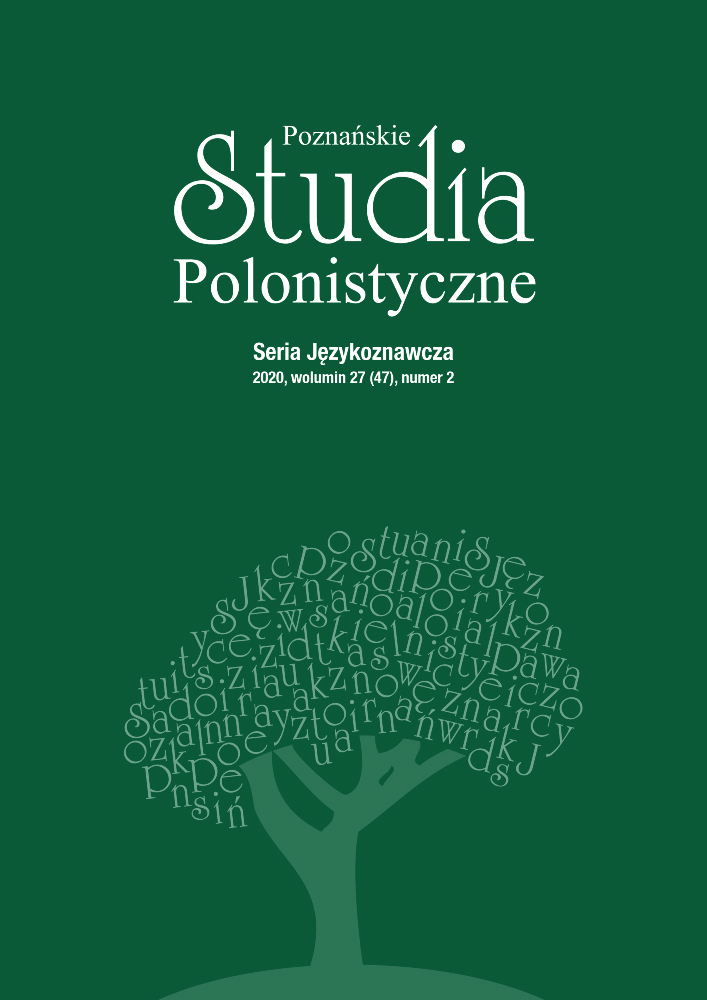Abstract
The article provides the characteristics and classification of the most frequentative verbs and verb phrases used in contemporary Silesian literature. It has been established that the largest number of the studied forms is related to the different ways people physically influence the reality that surrounds them and mental processes (i.e. cognitive, evaluative and descriptive ones). The lexical diversity between Polish standard lexis and Silesian literary usage amounts to fifty-eight percent. What influences this diversity is the presence of words of German and Czech origin which amount to almost a tenth of the Silesian lexicon. Slightly less than half of the verbs are derived forms, in the vast majority formed through prefixation, aspect suffixation and postfixation. The semantic and morphological structure of the studied verb forms demonstrates a farreaching intellectualisation and formal complexity of the Silesian lexicon.
References
Bąk Stanisław (1974), Mowa polska na Śląsku, Zakład Narodowy im. Ossolińskich Wydawnictwo, Wrocław.
Chlebda Wojciech (1993), Frazematyka, w: Encyklopedia kultury polskiej XX w., t. 2: Współczesny język polski, red. Jerzy Bartmiński, Wiedza o kulturze, Warszawa, s. 327–334.
Czesak Artur (2015), Współczesne teksty śląskie na tle procesów językotwórczych i standaryzacyjnych współczesnej Słowiańszczyzny, Księgarnia Akademicka, Kraków.
Greń Zbigniew (2006), Zakres wpływów niemieckich w leksyce gwar Śląska Cieszyńskiego, w: Slavica leguntur. Aktualne problemy badawcze slawistyki, red. Joanna Królak, Jerzy Molas, Wydział Polonistyki Uniwersytetu Warszawskiego, Warszawa, s. 57–70.
Grzegorczykowa Renata, Laskowski Roman, Wróbel Henryk, red. (1998), Gramatyka współczesnego języka polskiego. Morfologia, PWN, Warszawa.
Hentschel Gerd (2019), Obserwacje dotyczące rozpowszechnienia germanizmów leksykalnych we współczesnym regiolekcie śląskim, „LingVaria”, nr 1 (27), s. 113–132.
Jaroszewicz Henryk (2019), Rozwój języka Górnoślązaków w XXI wieku. Wybrane zagadnienia, „Zeszyty Łużyckie”, nr 53, s. 25–42.
Jaroszewicz Henryk (2020), Czy można mówić o istnieniu śląskiego języka literackiego? Współczesny uzus gramatyczno-ortograficzny literackiej odmiany etnolektu śląskiego, w: Area slavica 3. Jazyk na hranici – hranice v jazyku, red. Irena Bogoczova, Ostravská Univerzita. Filozofická fakulta, Ostrava, s. 175–184.
Kallus Bogdan (2015), Słownik gōrnoślōnskij gŏdki, Pro Loquela Silesiana, Katowice.
Łaziński Marek, red. (2008), Słownik zapożyczeń niemieckich w polszczyźnie, Wydawnictwo Naukowe PWN, Warszawa.
Nagórko Alicja (2002), Zarys gramatyki polskiej, Wydawnictwo Naukowe PWN, Warszawa.
Saloni Zygmunt, Świdziński Marek (2007), Składnia współczesnego języka polskiego, PWN, Warszawa.
Tambor Jolanta (2009), Propozycje kodyfikacji ortograficznej śląszczyzny, „Socjolingwistyka”, t. 22, s. 83–92.
Zaręba Alfred (1988), Szkice z dialektologii śląskiej, Śląski Instytut Naukowy, Katowice.
License
Authors
The Author declares that they are entitled to personal and property (material) copyrights to their work published in “Poznańskie Studia Polonistyczne. Seria Językoznawcza”, and that these rights are not limited by the terms of Author’s agreement. The Author warrants the originality, authorship, and sole ownership of all rights to the Work, and affirms that they have the right to grant all kinds of licenses hereinabove without infringing on the intellectual property rights of any third party, including personal rights.
The Author(s) retains copyright to their article and the right to freely dispose of the work, granting Adam Mickiewicz University in Poznań a non-exclusive, royalty-free licence under the Attribution-NoDerivatives 4.0 International (CC BY-ND 4.0) Creative Commons licence to use the Work without territorial restrictions for an indefinite period in the fields of use designated in the Author’s agreement.
Users
Interested Internet users are entitled to use works published in „Poznańskie Studia Polonistyczne. Seria Językoznawcza” since 2016 under the following conditions:
- attribution - obligation to provide, together with the distributed work, information about the authorship, title, source (link to the original work, DOI) and the license itself.
- no derivatives - the work must be preserved in its original form, without the author's consent it is not possible to distribute the modified work, such as translations, publications, etc.
Copyrights are reserved for all texts published before 2016.
Other
Adam Mickiewicz University in Poznań retains the right to the journal as a whole (including its layout, graphic design, title, cover design, logo and more).
